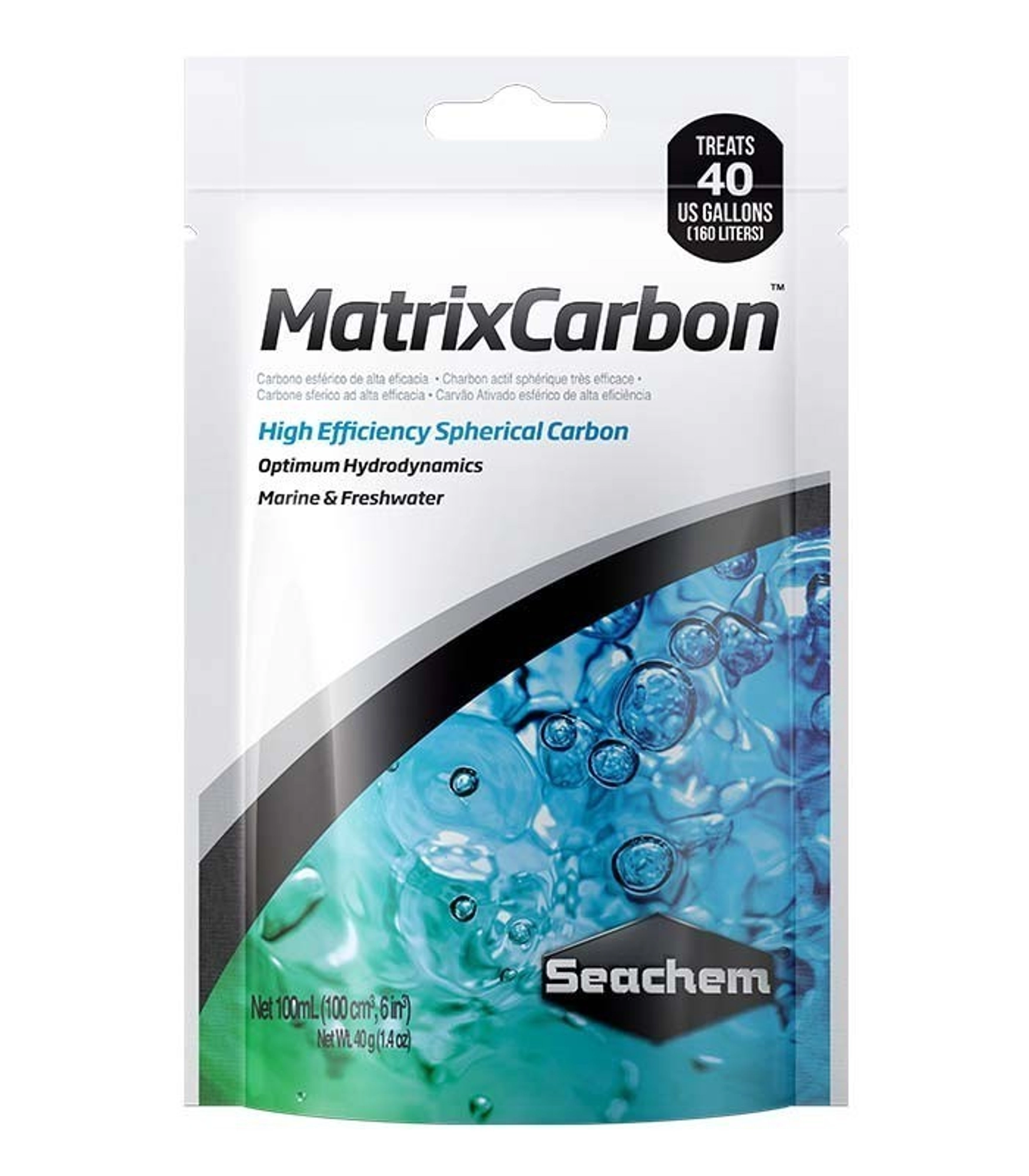

Product Details
MatrixCarbon is a truly unique activated carbon. Shaped in spherical beads, MatrixCarbon will not pack, hence permits maximum water flow and contact with the media, which improves bio filtration.
MatrixCarbon has a very low ash content as indicated by its minimal impact on pH. Even when added to distilled water, it does not raise pH above 7.0. While all carbons contain phosphate, regardless of false claims to the contrary, MatrixCarbon has the lowest detectable leachable phosphate content of all major carbon brands tested. MatrixCarbon outperforms other high grade carbons by at least two-fold when compared for total capacity to remove aquarium organic matter, rate of adsorption, and duration of use.
Advantages
While carbon is generally considered to be a chemical filter, that is not precisely true. It is in fact a mechanical filter as well, but it is only capable of mechanically filtering objects of molecular size. It functions through extremely small cracks and crevices, called macropores and micropores. Microporous carbons remove primarily metals and smaller ions (like trace minerals) and are best suited to air filtration, while macroporous carbons remove primarily larger organic molecules (like nitrogenous waste) and are best suited to water filtration.
The ingredients from which a carbon is manufactured determine whether it will be macro- or microporous. Carbons made from coconut shell and other organic products form microporous carbons, while carbons made from bituminous coal form macroporous carbons. MatrixCarbon is a bituminous coal-based, macroporous carbon. It is the only spherical carbon on the market, allowing for maximum water flow. It is sized to allow full penetration by water, but not small enough to escape filter bags. All carbons contain phosphate. However, that phosphate DOES NOT come from washing the carbon with phosphoric acid. Most carbons are washed with sulfuric acid. The phosphate is contained in the ash from the carbon source. The main purpose of acid-washing is to remove ash. Because of the hydrodynamic properties of MatrixCarbon carbon beads, more ash is washed from our carbon than any other. Therefore, it has the lowest leachable phosphate on the market.
FAQ
How long does your MatrixCarbon last?
A: Matrix Carbonis the only spherical shaped carbon on the market. It will not compact and create dead zones due to restricted water flow, and, consequently will use up all available absorptive sites before exhaustion. Actual time depends on initial water conditions. In very dirty water, it may last as little as a few hours; in very clean water it may last several months. In general, 3 - 6 months is typical.
You claim MatrixCarbon's spherical shape makes it a better carbon. Why does shape matter?
A: A spherical pellet has ideal hydrodynamic properties and provides for maximum water flow and contact without the compacting and channeling characteristic of granular activated carbon. Water channeling is likewise characteristic of carbon pelletized as cylindrical pellets. Such cylindrical pellets were originally engineered for air filtration and have poor water hydrodynamics. Matrix Carbon also has minimal impact on trace elements, an added bonus for the planted aquarium.
Compacting: Compacting occurs over time as the flat edges of granular carbon become situated against each other. Over time, the carbon becomes so tightly packed together that water flow is impeded. When this happens, the water to carbon contact is minimized.
Channeling: Where the problem with granular carbon is being packed too tightly, the problem with cylindrical pellets is not being packed tightly enough. As a result, channeling occurs. Water moves to easily through the channels between the carbon minimizing contact with absorptive sites.
Optimal Hydrodynamics: MatrixCarbon solves both compacting and channeling. Because of its unique spherical shape, MatrixCarbon provides maximum water flow and contact with a high density of adsorptive sites without the compacting of granular activated carbon.
Recently I used Cupramine in my tank. Can I use the MatrixCarbon to remove the Cupramine?
A: Yes, since Cupramine is bound to an organic you can use carbon to remove the product.
Will MatrixCarbon remove trace minerals from the water? I have a densely planted aquarium and want to be sure that the needed trace minerals and elements are not aggressively being removed by the carbon.
A: MatrixCarbon is an aggressive media and will have a minimal impact on trace elements. For this reason, you may want to consider Purigen. Purigen is an aggressive organic scavenging resin that is very selective in what it removes. It only wants nitrogenous organic material. This product also polishes water and is regenerable making it more cost effective in the long run.
A different company claims that their carbon contains no phosphate at all. If MatrixCarbon is so good, why does it still have phosphate?
A: All carbons are made from organic material (wood, nut shells, etc.), so they inherently contain phosphate - it is unavoidable. If a company claims their carbon contains no phosphate at all, it is either not a carbon (possibly a carbon-like substitute such as Renew) or the company is practicing some creative wording with regards to their carbon. MatrixCarbon has the lowest leachable phosphate on the market; it will add less phosphate to your water than any other carbon available.
Directions
250 mL will easily treat 400 L (100 US gallons) for several months. Use in a filter bag. Rinse before use. For best results, MatrixCarbon should be placed so as to maximize the flow of water through it. It may be used in a canister filter, chemical filtration module, box filter, or any high flow area of a trickle filter.
SEACHEM MATRIX CARBON 100ML (SC-105)
Product Options
100ml
Delivery
Quantity
N30 Ang Mo Kio
Visit shop
Aquarium Fishes, Tanks & Supplies From N30 Ang Mo Kio


 SG
SG


